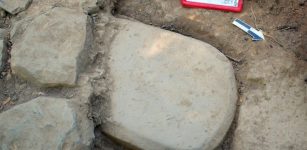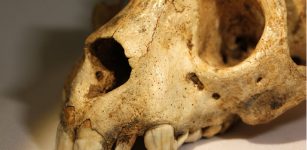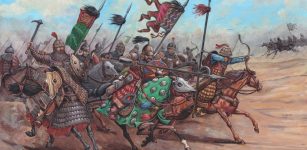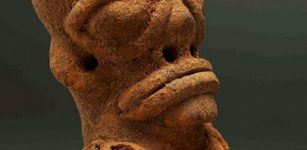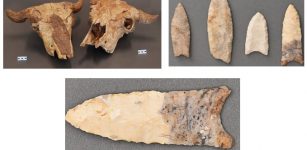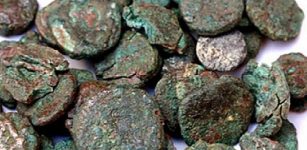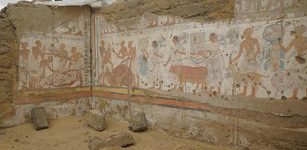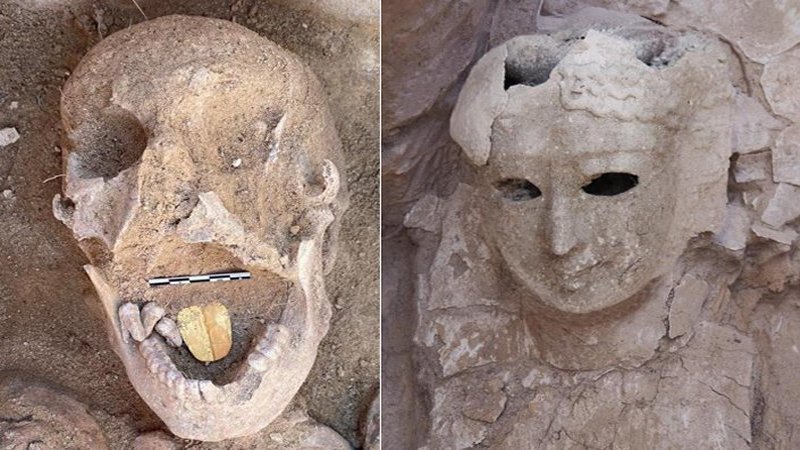Huge Viking Treasure Hoard Found At Fyrkat Ring Castle By Metal Detectorists
Jan Bartek – MessageToEagle.com – A group of metal detectorists examining a field near the Viking castle Fyrkat have discovered two remarkable treasures. The two Viking treasures were buried a few meters apart, and both contained many small silver coins and cut-up silver jewelry, which probably served as a means of payment by weight. Altogether, the two treasures include up to 300 pieces of silver, of which approximately 50 are whole coins.
Aerial view of the Fyrkat Viking ring castle ruins. Credit: Adobe Stock – Cavan
Fyrkat is a former Viking ring castle in Denmark, dating from c. 980 AD. About 1,000 years ago, legendary King Harald Bluetooth built several impressive Viking fortresses.
Finding Viking treasures in Denmark is not unusual, but finding two so close to Fyrkat is amazing. The metal detectors who are members of Nordjysk Detektorforening were lucky because due to modern ploughing, harrowing, and sowing, the hoards have been disturbed and spread over a larger area.
The Viking hoards were originally deposited quite close to each other. As a result of the modern disturbances the coins and other silver are well mixed together. It is, therefore, difficult for the archaeologists to determine with 100 percent certainty which of the treasures the individual finds belonged to. But it can be ascertained that both treasures contain a mixture of Danish, German, and Arab coins.
Metal detectorists found several precious coins. Credit: Nordjyske Museer
The Danish coins, in particular, have attracted the interest of archaeologists. Among other things, these are so-called cross coins struck under King Harald Bluetooth( Blåtand) in the 970-80s.
Especially for King Harald’s late coins is the cross on one side. His earlier coins were not decorated with a cross. He, therefore, probably introduced the cross coins as propaganda in connection with his Christianization of the Danes – i.e. as a further spread of Harald’s message on the great Jelling stone, which was erected around the year 965.
Harald Bluetooth’s cross coins were in circulation for less than a few decades before he lost the power struggle to his son Svend Tveskæg in the mid-980s. The treasures, therefore, originate from this highly dramatic period in the Viking Age.
Loot From Looting
In addition to the coins, the treasures contain two other particularly interesting pieces of silver. They weigh approximately 70 grams, and they obviously come from the same piece of jewelry. These are two ornately braided decorated balls on a small piece of cut silver rod, which was originally part of an unusually large ring pin.
The sign of the cross helped scientists to date the coins. Credit: Nordjyske Museer
Such ring pins were especially used by men at the top of society in Viking Age Ireland and on the neighboring islands. Some of this silver jewelry weighed around ½ kilo, and assessed based on the two fragments, the jewelry from Bramslev belongs in this category. Bishops and kings wore jewelry of this size and quality.
According to the Historical Museum of Northern Jutland, the jewelry probably originates from a raiding expedition, and the Danish Vikings did not appreciate the fine artistic details of the jewelry. For them, it was only the weight of the silver jewelry that was important. Therefore, the ring pin was chopped into pieces, and most of the jewelry was probably used for payment or remelted into new jewelry in the Scandinavian style. In those days, various objects could be used as payments. For example, a woman cleaning a house found a rare Viking treasure. In the cellar, there were 32 iron ingots that were most likely used as payment.
Unrest At Fyrkat?
As such, Harald Blåtand’s cross coins and fragments of silver jewelry are not uncommon in treasure finds from the latter half of the 900s, but what makes these Viking treasures extra interesting is the location: a Viking settlement close to Fyrkat.
“The two silver treasures constitute a fantastic story in themselves, but to find them abandoned in a settlement only eight kilometers from Haralds Blåtand’s Viking fortress Fyrkat is incredibly exciting,” says archaeologist and museum inspector at North Jutland Museums, Torben Trier Christiansen.
Fyrkat, together with Harald Blåtand’s other ring castles, were only used for a very short time, around 980. It is unknown why the ring castles were closed down, but traces of battles have been found at Trelleborg on Zealand.
Arabic letters were visible on one of the coins. Credit: Nordjyske Museer
“Perhaps the castles were not given up entirely voluntarily, and perhaps it happened in connection with the final showdown between Harald Blåtand and his son Svend Tveskæg. The Bramslev treasures were apparently buried around the same time or shortly after the castles were abandoned.
If there have been disturbances at Fyrkat, it makes good sense that the local magnate here at Bramslev has chosen to hide his valuables out of the way, ” says Torben Trier Christiansen.
Bramslet Has Been An Important Place
According to Torben Trier Christiansen, Bramslev’s high location overlooking large parts of Mariagerfjord’s inner parts can almost only be interpreted as meaning that the village here must have played a significant role in Fyrkat’s defense.
The Fyrkat treasures are significant and shed new light on Viking activities around the fort. Credit: Nordjyske Museer
“From the hill at Bramslev, you were able to quickly warn the troops on the castle against incoming enemy fleets from the Kattegat,” explains Torben Trier Christiansen.
This is no ordinary Viking settlement, and the archaeologists from North Jutland Museums are very interested in discovering more about the Viking village at the site where the treasures were found.
There are probably no more silver treasures to be found. Still, during the investigations this spring, it was established that both of the two silver treasures found were originally buried inside or very close to buildings.
See also: More Archaeology News
The upcoming investigations this autumn will focus on illuminating the traces of these buildings and finding answers as to whether the houses actually stood here when the treasures were buried and whether they are completely ordinary Viking houses.
But as early as July 1, those interested can learn more about the two silver treasures. They can be seen at the Aalborg Historical Museum, where they are displayed this summer.
Written by Jan Bartek – MessageToEagle.com – AncientPages.com Staff Writer






